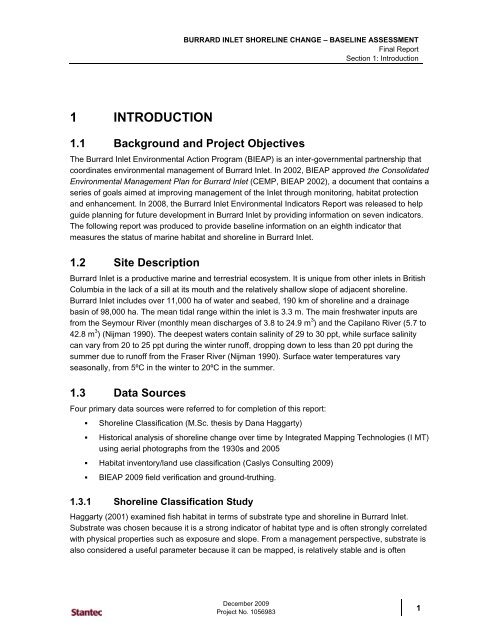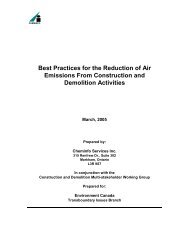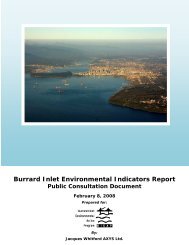BURRARD INLET SHORELINE CHANGE – BASELINE ASSESSMENT
BURRARD INLET SHORELINE CHANGE – BASELINE ASSESSMENT
BURRARD INLET SHORELINE CHANGE – BASELINE ASSESSMENT
Create successful ePaper yourself
Turn your PDF publications into a flip-book with our unique Google optimized e-Paper software.
1 INTRODUCTION<br />
<strong>BURRARD</strong> <strong>INLET</strong> <strong>SHORELINE</strong> <strong>CHANGE</strong> <strong>–</strong> <strong>BASELINE</strong> <strong>ASSESSMENT</strong><br />
Final Report<br />
Section 1: Introduction<br />
1.1 Background and Project Objectives<br />
The Burrard Inlet Environmental Action Program (BIEAP) is an inter-governmental partnership that<br />
coordinates environmental management of Burrard Inlet. In 2002, BIEAP approved the Consolidated<br />
Environmental Management Plan for Burrard Inlet (CEMP, BIEAP 2002), a document that contains a<br />
series of goals aimed at improving management of the Inlet through monitoring, habitat protection<br />
and enhancement. In 2008, the Burrard Inlet Environmental Indicators Report was released to help<br />
guide planning for future development in Burrard Inlet by providing information on seven indicators.<br />
The following report was produced to provide baseline information on an eighth indicator that<br />
measures the status of marine habitat and shoreline in Burrard Inlet.<br />
1.2 Site Description<br />
Burrard Inlet is a productive marine and terrestrial ecosystem. It is unique from other inlets in British<br />
Columbia in the lack of a sill at its mouth and the relatively shallow slope of adjacent shoreline.<br />
Burrard Inlet includes over 11,000 ha of water and seabed, 190 km of shoreline and a drainage<br />
basin of 98,000 ha. The mean tidal range within the inlet is 3.3 m. The main freshwater inputs are<br />
from the Seymour River (monthly mean discharges of 3.8 to 24.9 m 3 ) and the Capilano River (5.7 to<br />
42.8 m 3 ) (Nijman 1990). The deepest waters contain salinity of 29 to 30 ppt, while surface salinity<br />
can vary from 20 to 25 ppt during the winter runoff, dropping down to less than 20 ppt during the<br />
summer due to runoff from the Fraser River (Nijman 1990). Surface water temperatures vary<br />
seasonally, from 5ºC in the winter to 20ºC in the summer.<br />
1.3 Data Sources<br />
Four primary data sources were referred to for completion of this report:<br />
Shoreline Classification (M.Sc. thesis by Dana Haggarty)<br />
Historical analysis of shoreline change over time by Integrated Mapping Technologies (I MT)<br />
using aerial photographs from the 1930s and 2005<br />
Habitat inventory/land use classification (Caslys Consulting 2009)<br />
BIEAP 2009 field verification and ground-truthing.<br />
1.3.1 Shoreline Classification Study<br />
Haggarty (2001) examined fish habitat in terms of substrate type and shoreline in Burrard Inlet.<br />
Substrate was chosen because it is a strong indicator of habitat type and is often strongly correlated<br />
with physical properties such as exposure and slope. From a management perspective, substrate is<br />
also considered a useful parameter because it can be mapped, is relatively stable and is often<br />
December 2009<br />
Project No. 1056983<br />
1
















